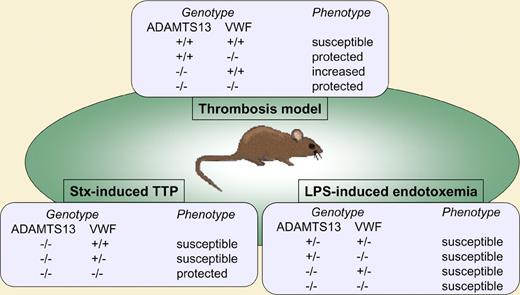In this issue of Blood, using various genetic combinations of mice, Chauhan and colleagues are able to directly assess and demonstrate the role of VWF in shigatoxin-induced thrombotic thrombocytopenic purpura. Additionally, thrombosis studies performed in double-deficient mice point to VWF as the only relevant substrate for ADAMTS13.
Thrombotic thrombocytopenic purpura (TTP) is a thrombotic microangiopathy characterized by a pentad of symptoms: fever, microangiopathic hemolytic anemia, thrombocytopenia, central nervous system abnormalities, and renal impairment. Deficiency in the metalloprotease ADAMTS13 constitutes the basis of TTP pathogenesis, although additional genetic and/or environmental factors are necessary for TTP onset.1 In plasma, ADAMTS13 is necessary for the cleavage of von Willebrand factor (VWF) multimers and the proteolytic inactivation of the largest forms, which are very thrombogenic. Other features of TTP are the presence of ultra-large VWF (UL-VWF) multimers in the plasma of patients and the presence of thrombi enriched in platelets and VWF.2 Although all observations point to an important role for VWF in TTP, no direct evidence is available.
To tackle this problem, Chauhan and colleagues generated mice that were deficient for both VWF and ADAMTS13 and studied them in 3 different settings. In the first model, the authors used mice on a TTP-susceptible background (CASA/Rk-C57BL/6–129×1/Sv) and submitted them to shigatoxin (Stx) challenge. In contrast to ADAMTS13-deficient mice, which develop severe thrombocytopenia and have a high mortality rate,3 mice deficient in both ADAMTS13 and VWF did not respond to the challenge, demonstrating the requirement for VWF in Stx-induced TTP-like symptoms. Furthermore, by using mice that were heterozygous for VWF and displayed a wide range of VWF levels, Chauhan and colleagues were able to demonstrate that a minimal level of VWF is required for induction of TTP-like thrombocytopenia.
Various studies have reported links between VWF, ADAMTS13, and sepsis.4-6 The authors therefore used an LPS-induced endotoxemia model. In C57BL/6 mice, deficiency in VWF, ADAMTS13, or both proteins had no effect on LPS-induced thrombocytopenia or mortality. The authors conclude that the mechanisms of thrombocytopenia differ between Stx and LPS, while acknowledging that the different genetic backgrounds of the mice used for both studies may also contribute to the variation observed. These results appear to contradict recent findings that show an association between reduced ADAMTS13 levels and poor prognosis in severe sepsis.6 It should be noted, however, that LPS-induced endotoxemia does not fully represent a true model of sepsis, and therefore may not be comparable to the patient populations studied.
In the third model, Chauhan and colleagues built on their previous report showing that ADAMTS13-deficient mice display a prothrombotic phenotype in FeCl3-induced arterial thrombosis.7 They demonstrate here that VWF deficiency completely abrogates this prothrombotic phenotype, because ADAMTS13/VWF-deficient mice behave exactly like VWF-deficient mice. These results strongly support the notion that VWF is the only substrate of ADAMTS13, at least in thrombosis.
Stx experiments were carried out in mixed CASA/Rk-C57BL/6-129×1/Sv background mice, while LPS and thrombosis experiments were performed in pure C57BL/6 background mice.
Stx experiments were carried out in mixed CASA/Rk-C57BL/6-129×1/Sv background mice, while LPS and thrombosis experiments were performed in pure C57BL/6 background mice.
Altogether, these findings confirm that, so far, no function of ADAMTS13 has been identified as being independent of VWF. A pas de deux between ADAMTS13 and its substrate, VWF, is apparently needed for ADAMTS13 to be of physiological relevance.
Conflict-of-interest disclosure: The author declares no competing financial interests. ■


This feature is available to Subscribers Only
Sign In or Create an Account Close Modal